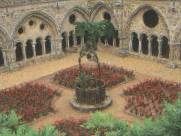
![]()

![]() The original religious foundation on this site was a Benedictine
establishment. The position is in a classic
situation for a Benedictine abbey, tucked into a narrow,
sheltered valley remote from the outside world. It is located
in the
Corbières area in the Aude
département, just off the Autoroute between Narbonne
and Carcassonne.
The original religious foundation on this site was a Benedictine
establishment. The position is in a classic
situation for a Benedictine abbey, tucked into a narrow,
sheltered valley remote from the outside world. It is located
in the
Corbières area in the Aude
département, just off the Autoroute between Narbonne
and Carcassonne.
The Cistercian Abbey of Fontfroide was founded in 1145, and became one of the most important and richest Cistercian abbeys in the Midi. It was the murder of a monk from Fontfroide, the papal legate Pierre de Castelnau, at dawn, on the 15th of January 1208, that provided Pope Innocent III with his pretext for the Cathar Crusade. Olivier de Termes is though to be buried here in the chapel of Saint Bernard (dedicated to Bernard of Clairvaux), which he founded. One of Fontfroide's abbots, Jacques Fournier, became Bishop of Pamiers in 1317 and a keen inquisitor (responsible for the arrest of the village of Montaillou). In 1334 he was elected Pope Benedict XII.

![]() The
abbey fell into decay following the Plague of 1348.
It was subsequently run by noblemen who were given the title
of Abbots without being monks. They added various
luxuries which make parts of the abbey look more like a
château than a Cistercian
abbey.
The
abbey fell into decay following the Plague of 1348.
It was subsequently run by noblemen who were given the title
of Abbots without being monks. They added various
luxuries which make parts of the abbey look more like a
château than a Cistercian
abbey.
A local family bought the ruins early this century and spent years restoring it. The result is a building that looks even less like a Cistercian abbey than it did before. The brilliantly coloured 20th-century stained glass windows in the church for example are pretty enough, but one of the characteristics of the Cistertians was a love of simplicity, including plain clear glass. The church itself has the simple, clean lines typical of Cistercian abbeys and is entered via a hansome 13th-century cloister.
A rose garden contains over 2,000 bushes, including medieval varieties. Visits are by guided tour. There is one every 45 minutes, in French only. Leaflets are available in English and other languages. There are occasional summer concerts of Gregorian chant and similar music in the abbey church. The abbey now also boasts a wine-tasting cellar, and a restaurant in the courtyard outside (run by the previously Michelin-starred chef).


















